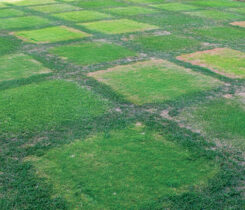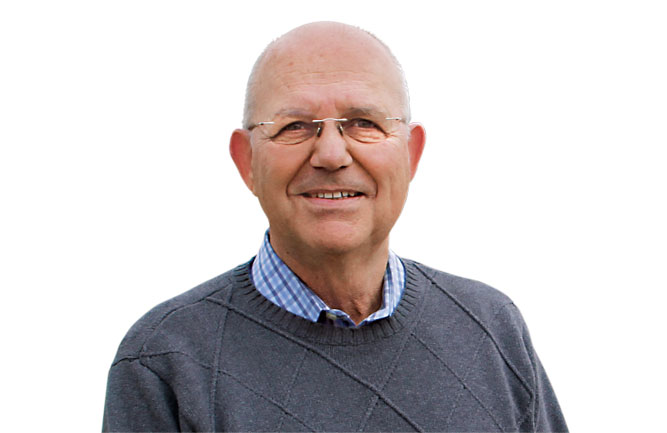Kabuto: Spring dead spot’s archnemesis

The scenic Nutters Crossing Golf Club in Salisbury, Md., where Pat Riebe is superintendent. (Photo: Pat Riebe)
As a severe disease of warm-season turfgrasses, spring dead spot (SDS) is managed throughout the Transition Zone of the United States. Caused by a fungal infection that occurs in the autumn months (particularly as warm-season turf is approaching dormancy), SDS can lead to widespread areas of dead turf that manifest the following spring.
While some cultural practices have been identified to reduce SDS severity, many superintendents often resort to preventive fungicide applications for control. For the last several years, superintendents have widely used tebuconazole as an economic choice, but have observed variability in its efficacy.
Nutters Crossing Golf Club, an Ault, Clark & Associates design located in Salisbury, Md., has battled SDS for several years, as environmental conditions often are conducive for the disease to develop. To treat the issue, superintendent Pat Riebe has sprayed tebuconazole three times a year at three-week intervals.
Unfortunately, he has had little success with the fungicide, as it has not been overly efficacious despite its overall cost effectiveness. Aside from the usage of tebuconazole, Riebe has encountered one other significant issue: Due to a tight budget, Nutters Crossing’s bermudagrass fairways do not receive the recommended rates of nutrients all season long.
With this in mind, Joseph Roberts, Ph.D., assistant professor of turfgrass pathology at the University of Maryland, established a relationship with Nutters Crossing in 2015, as he sought to evaluate products for their effectiveness, particularly for controlling the pathogen that causes SDS. He already had been working to identify accepted management practices to reduce SDS, with a specific interest in examining new fungicides belonging to the succinate dehydrogenase inhibitor (SDHI) class of chemistry.

Riebe noticed nearly 100 percent effectiveness of Kabuto, as seen on the right side of the fairway (left photo). To compare, fluxapyroxad + pyraclostrobin was +-98 percent effective, as seen in the second photo above; fluxapyroxad + pyraclostrobin was applied on the left side of the fairway. (Photo: Pat Riebe)
After two years of the trials, PBI-Gordon Corp. sought to gain more information related to SDS control and began working with Roberts and Maryland’s turfgrass pathology program. Because of this association, PBI-Gordon’s Brian Aynardi, Ph.D., Northeast research scientist, was introduced to Riebe.
“Dr. Roberts was overseeing SDS fungicide efficacy trials at the course, so I visited to view the trials and meet Pat,” Aynardi says. “After I met with Pat, Dr. Roberts suggested a large-scale demo (that) may help him control the disease on several fairways while also evaluating efficacy in a real-world scenario.”
At the time, PBI-Gordon had been seeking methods to demo its Kabuto Fungicide SC. Nutters Crossing had severe symptoms of SDS on multiple fairways, along with a superintendent who was willing to help manage trials, so PBI-Gordon had finally found the ideal course to conduct its Kabuto demo.
Let the trials begin
During the summer of 2018, Riebe and Aynardi developed the following plan. In October, three of the course’s most infested fairways would be sprayed with Kabuto. Only half of each fairway would be treated with the PBI-Gordon product, while the other half of the fairway would be sprayed with a competitive product. The nontreated area would be approximately 10 to 15 yards wide; this width would determine the impact of the treatments as well as the ways in which they compare to one another.
“We decided to evaluate Kabuto at the recommended split-application rate (1.6 fl. oz. per 1,000 square feet, followed by another 1.6 fl. oz. per 1,000 square feet) 21 to 28 days apart,” Aynardi explains. “This rate has performed consistently well in university trials.”
“It would then be compared to two other SDHI stand-alone active ingredients,” he continues, “as well as a premix product containing an SDHI. The application would also have to occur when soil temperatures at the 2-inch depth were approximately 70 degrees F for five to seven consecutive days.”
This temperature is particularly recommended because SDS begins in the fall when soil temperatures decline to 70 degrees F and below (it is always dormant in the spring and summer). Not to mention, fungicides combat the disease — typically renowned as the most destructive bermudagrass disease in the world — most effectively when soil temperatures are between 60 degrees F and 80 degrees F.
Riebe began the trial on Oct.1, 2018, as he applied Kabuto as well as other competitors on three Patriot Bermuda sand-based fairways that frequently had two considerable issues. First, fungicides filtered out of them much faster than Nutters Crossing’s other fairways. Secondly, soil temperatures fluctuated more when compared to the other 15 fairways, as they’d either warm up faster or cool down quicker than normal.
All fungicides were applied in a carrier volume of 87.12 gallons per acre, and each fairway had an approximately 5,000-square-foot-wide area left completely untreated. On the first fairway, they sprayed Kabuto at 1.6 fl. oz. per 1,000 square feet on one half, while they sprayed 0.47 fl. oz. per 1,000 square feet of fluxapyroxad + pyraclostrobin on the other half. In comparison, the second fairway was again sprayed with Kabuto (1.6 fl. oz. per 1,000 square feet) on one half, but with penthiopyrad (0.7 oz. per 1,000 square feet) on the other half. Finally, they sprayed the third fairway with Kabuto on one half (yet again 1.6 fl. oz. per 1,000 square feet) and pydiflumetofen on the other half (14 fl. oz. per acre).
This exact application schedule was followed yet again on Oct. 30, 2018. After each application, Riebe personally watered them in with 0.25-inch of irrigation; he also personally sprayed every fungicide during both days of the trial. In addition, Riebe conducted a side trial in which he sprayed Kabuto at a lighter rate (1.0 fl. oz. per 1,000 square feet) on two other fairways. These applications also were conducted on Oct. 1 and Oct. 30 and watered in immediately (once again with 0.25 inch of irrigation).
“The results of the side trial were about plus 90 percent effectiveness,” he states. “To compare, when I sprayed three applications of tebuconazole on the fairways in the past, I typically noticed about 20-percent effectiveness.”
The influence of Kabuto
During each application, Patrick Bowers, Delaware, eastern North Carolina, Maryland and Virginia sales representative for PBI-Gordon, viewed each fairway and assisted whenever Riebe needed help. PBI-Gordon provided Kabuto free of charge, while the competitor products were purchased by PBI-Gordon (from a distributor) and personally delivered to Riebe.
Aside from the cost effectiveness of the trials, Riebe also noticed one other substantial positive: results. Each fairway had nearly 100-percent effectiveness regarding the reduction or removal of SDS.
- First Fairway: Currently, there are few symptoms of SDS (primarily circular patches of disease featuring dark and rotten rhizomes, roots and stolons), as the turf has recovered quickly. Fluxapyroxad + pyraclostrobin was 98-percent-plus effective, while Kabuto was almost 100-percent effective.
- Second Fairway: Right now, there are still some vague symptoms of SDS. However, the turf’s recovery is nearly complete. Penthiopyrad was 95-percent-plus effective, while Kabuto was once again roughly 100-percent effective.
- Third Fairway: Presently, there are some symptoms of SDS, yet the turf is almost recovered now. Although pydiflumetofen was 90-percent-plus effective, Kabuto continued to maintain its consistency, as it was approximately 100-percent effective.
“From what I have seen over the last three years of multiple trials when I first began working at Nutters Crossing, Kabuto has performed the best of all the fungicides we’ve used,” Riebe says. “Not only has it helped remove SDS considerably, but it has also increased the green-up of the bermudagrass faster than the other chemicals used during the fall.”
“Without question,” he adds, “it proved to be the very best product for SDS treatment. There’s simply no comparison.”
Aynardi was also extremely satisfied with the trial results, noting that significant disease was observed only in the areas of the fairways that weren’t treated with a fungicide, whereas he noticed outstanding disease control in the Kabuto-treated areas.
“This demo showed that Kabuto provides outstanding control of SDS on a golf course that exhibits severe symptoms of the disease when compared to leading competitor fungicides,” he states.
Of equal importance, Aynardi also is pleased about the ways in which Riebe worked in conjunction with Roberts and the PBI-Gordon team to discover new, innovative solutions to better control — and one day potentially eliminate — SDS.
“The trial really demonstrated one of PBI-Gordon’s primary core values: partnership,” he stresses. “We look forward to partnering with superintendents like Pat Riebe, golf courses such as Nutters Crossing and university researchers like Dr. Roberts once again in the future, as we strive to offer more solutions to courses’ most pressing issues.”












